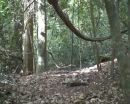(Press-News.org) A University of Cincinnati research project is taking a groundbreaking approach to monitoring groundwater resources near fracking sites in Ohio. Claire Botner, a UC graduate student in geology, will outline the project at The Geological Society of America's Annual Meeting & Exposition. The meeting takes place Oct. 19-22, in Vancouver.
Botner's research is part of UC Groundwater Research of Ohio (GRO), a collaborative research project out of UC to examine the effects of fracking (hydraulic fracturing) on groundwater in the Utica Shale region of eastern Ohio. First launched in Carroll County in 2012, the GRO team of researchers is examining methane levels and origins of methane in private wells and springs before, during and after the onset of fracking. The team travels to the region to take water samples four times a year.
Amy Townsend-Small, the lead researcher for GRO and a UC assistant professor of geology, says the UC study is unique in comparison with studies on water wells in other shale-rich areas of the U.S. where fracking is taking place – such as the Marcellus Shale region of Pennsylvania.
Townsend-Small says water samples finding natural gas-derived methane in wells near Pennsylvania fracking sites were taken only after fracking had occurred, so methane levels in those wells were not documented prior to or during fracking in Pennsylvania.
Hydraulic fracturing, or fracking, involves using millions of gallons of water mixed with sand and chemicals to break up organic-rich shale to release natural gas resources.
Proponents say the practice promises a future in lower energy prices, an increase in domestic jobs and less dependence on foreign oil from unstable overseas governments.
Opponents raise concerns about increasing methane gas levels (a powerful greenhouse gas) and other contamination involving the spillover of fracking wastewater in the groundwater of shale-rich regions.
"The only way people with private groundwater will know whether or not their water is affected by fracking is through regular monitoring," says Townsend-Small.
The Ohio samples are being analyzed by UC researchers for concentrations of methane as well as other hydrocarbons and salt, which is pulled up in the fracking water mixture from the shales. The shales are ancient ocean sediments.
Botner's study involves testing on 22 private wells in Carroll County between November 2012 and last May. The first fracking permits were issued in the region in 2011. So far, results indicate that any methane readings in groundwater wells came from organic matter. In less than a handful of cases, the natural methane levels were relatively high, above 10 milligrams per liter. However, most of the wells carried low levels of methane.
The UC sampling has now been expanded into Columbiana, Harrison, Stark and Belmont counties in Ohio. Researchers then review data on private drinking water wells with the homeowners. "We're working on interacting with these communities and educating them about fracking as well as gathering scientific data, which is lacking on a very sensitive issue," says Botner. "It can also be reassuring to receive data on their water supplies from an objective, university resource."
The team also is seeking additional funding to begin monitoring groundwater wells near wastewater injection wells, where fracking brine is deposited after the wells are drilled.
INFORMATION:
Funding for Botner's research to be presented at the GSA meeting is supported by a grant from the Missouri-based Deer Creek Foundation.
Botner is among UC graduate students and faculty who are presenting more than two dozen research papers, PowerPoint presentations or poster exhibitions at the GSA meeting. The meeting draws geoscientists from around the world representing more than 40 different disciplines.
UC's nationally ranked Department of Geology conducts field research around the world in areas spanning paleontology, Quaternary geology, geomorphology, sedimentology, stratigraphy, tectonics, environmental geology and biogeochemistry.
The Geological Society of America, founded in 1888, is a scientific society with more than 26,500 members from academia, government and industry in more than 100 countries. Through its meetings, publications and programs, GSA enhances the professional growth of its members and promotes the geosciences in the service of humankind.
ANN ARBOR—Lake Erie has become increasingly susceptible to large blooms of toxin-producing cyanobacteria since 2002, potentially complicating efforts to rein in the problem in the wake of this year's Toledo drinking water crisis, according to a new study led by University of Michigan researchers.
Since the detection of the toxin microcystin left nearly half a million Ohio and Michigan residents without drinking water for several days in early August, discussions of ways to prevent a recurrence have largely focused on the need to reduce the amount of phosphorus fertilizer ...
As our ability to assess the pandemic risk from strains of influenza virus increases with the latest scientific developments, we must not allow ourselves to become complacent that the most substantial threats have been identified, argue an international consortium of scientists.
Influenza pandemics arise when a new virus strain – against which humans have yet to develop widespread immunity – spreads in the human population. There have been five such pandemics in the past 100 years, the worst of which – the 1918 Spanish Flu – cost 50 million lives ...
"Imagine a heavy ball rolling on an elastic net: what happens?" asks Daniele Fausti, researcher at Elettra Sincrotrone of Trieste and the University of Trieste. That's how Fausti explains the concept of "dressing" in physics: "the ball's movement is slowed down because each movement is accompanied by a deformation of the net: the sphere no longer behaves like a free sphere (i.e., that rolls on a rigid plane), but like a sphere that is 'dressed' by the net's deformation". Why is this "dressing" concept so important? "Because it's what physicists believe explains superconductivity ...
A UNIVERSITY of Huddersfield researcher has shown that tiny tweaks to the soundtrack can make TV adverts much more memorable, increasing their commercial impact.
The necessary adjustments are imperceptible to the ear and eye. But Andy Rogers – in the last stages of his PhD project at the University – has proved that there are considerable perceptual improvements if the synchronisation between the music and the visual content of the commercial is altered by just tenths of a second.
Joined by his PhD supervisor, Dr Ian Gibson, Andy has just presented his ...
VIDEO:
This video shows a chimpanzee who has constructed a tool with which to investigate a camera (Nimba mountains, Guinea).
Click here for more information.
West African chimpanzees will search far and wide to find Alchornea hirtella, a spindly shrub whose straight shoots provide the ideal tools to hunt aggressive army ants in an ingenious fashion, new research shows.
The plant provides the animals with two different types of tool, a thicker shoot for 'digging' and a more ...
COLUMBUS, Ohio—Our view of other solar systems just got a little more familiar, with the discovery of a planet 25,000 light-years away that resembles our own Uranus.
Astronomers have discovered hundreds of planets around the Milky Way, including rocky planets similar to Earth and gas planets similar to Jupiter. But there is a third type of planet in our solar system—part gas, part ice—and this is the first time anyone has spotted a twin for our so-called "ice giant" planets, Uranus and Neptune.
An international research team led by Radek Poleski, postdoctoral ...
This news release is available in German. Public spending appears to have contributed substantially to the fact that life expectancy in eastern Germany has not only increased, but is now almost equivalent to life expectancy in the west. While the possible connection of public spending and life expectancy has been a matter of debate, scientists at the Max Planck Institute for Demographic Research (MPIDR) have now for the first time quantified the effect. They found that for each additional euro the eastern Germans received in benefits from pensions and public health ...
VIDEO:
Fruit fly border cells form clusters of six to eight cells, which display directional migration during oogenesis. Migration of border cells in egg chambers can be examined in detail by...
Click here for more information.
Cell migration is important for development and physiology of multicellular organisms. During embryonic development individual cells and cell clusters can move over relatively long distances, and cell migration is also essential for wound healing and many ...
Researchers from the University of Sheffield have found vital new evidence on how to target and reverse the effects caused by one of the most common genetic causes of Parkinson's.
Mutations in a gene called LRRK2 carry a well-established risk for Parkinson's disease, however the basis for this link is unclear.
The team, led by Parkinson's UK funded researchers Dr Kurt De Vos from the Department of Neuroscience and Dr Alex Whitworth from the Department of Biomedical Sciences, found that certain drugs could fully restore movement problems observed in fruit flies carrying ...
CORVALLIS, Ore. – Since the first undersea methane seep was discovered 30 years ago, scientists have meticulously analyzed and measured how microbes in the seafloor sediments consume the greenhouse gas methane as part of understanding how the Earth works.
The sediment-based microbes form an important methane "sink," preventing much of the chemical from reaching the atmosphere and contributing to greenhouse gas accumulation. As a byproduct of this process, the microbes create a type of rock known as authigenic carbonate, which while interesting to scientists was ...




